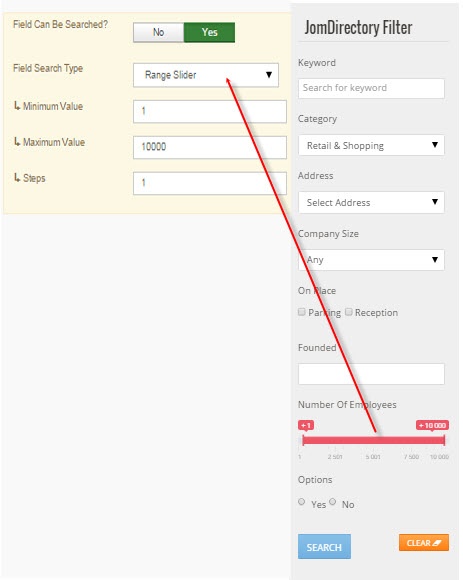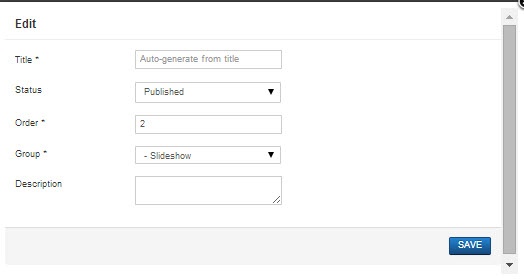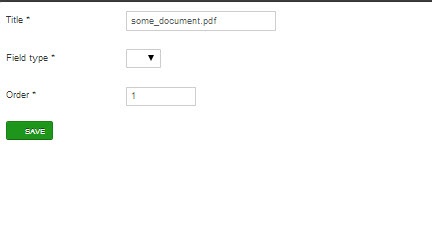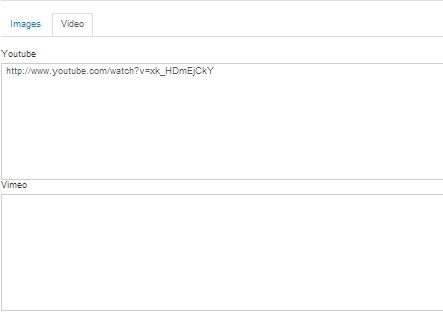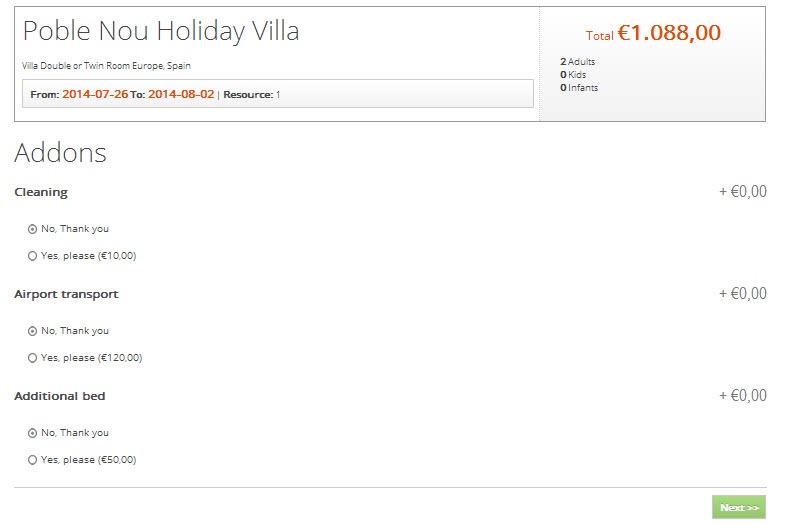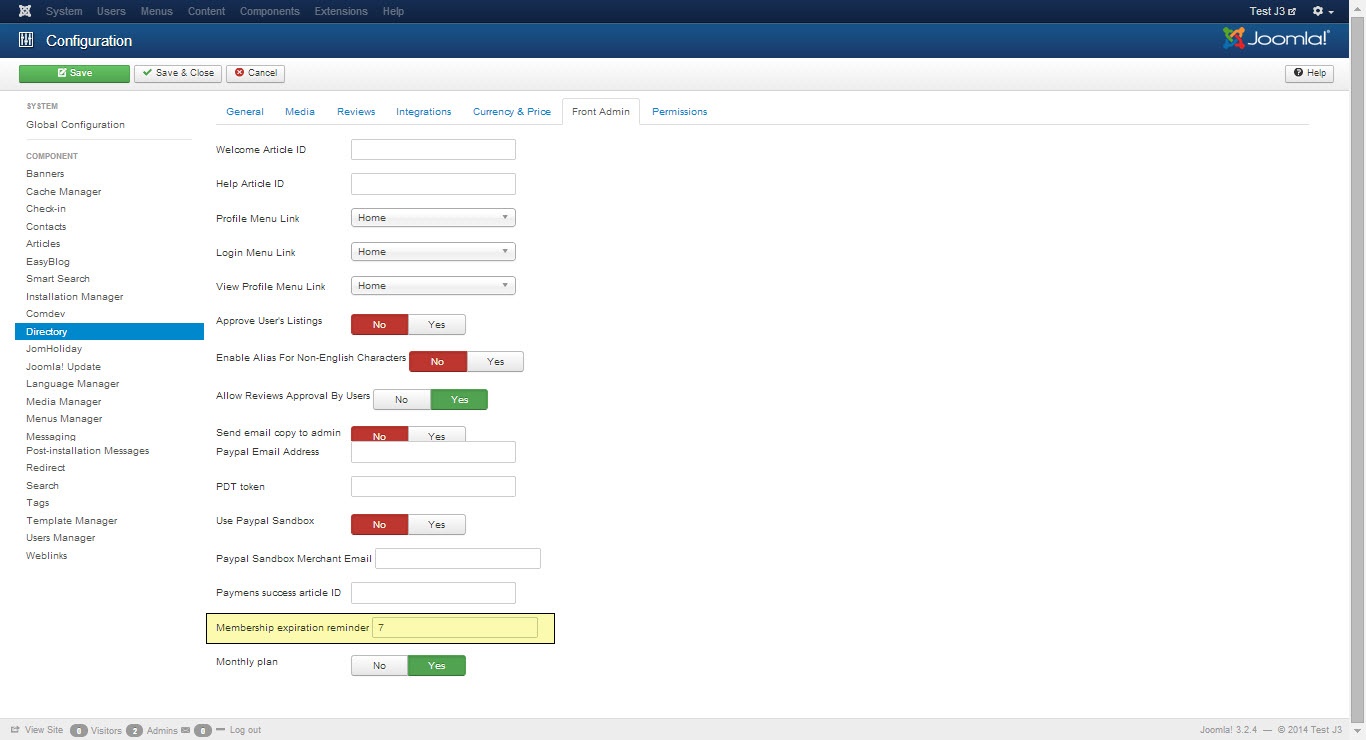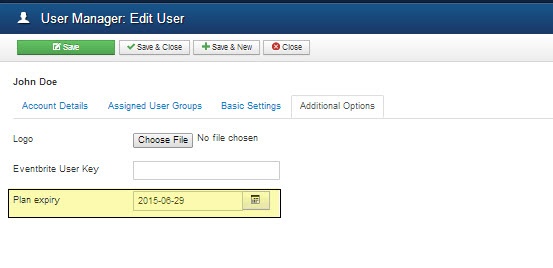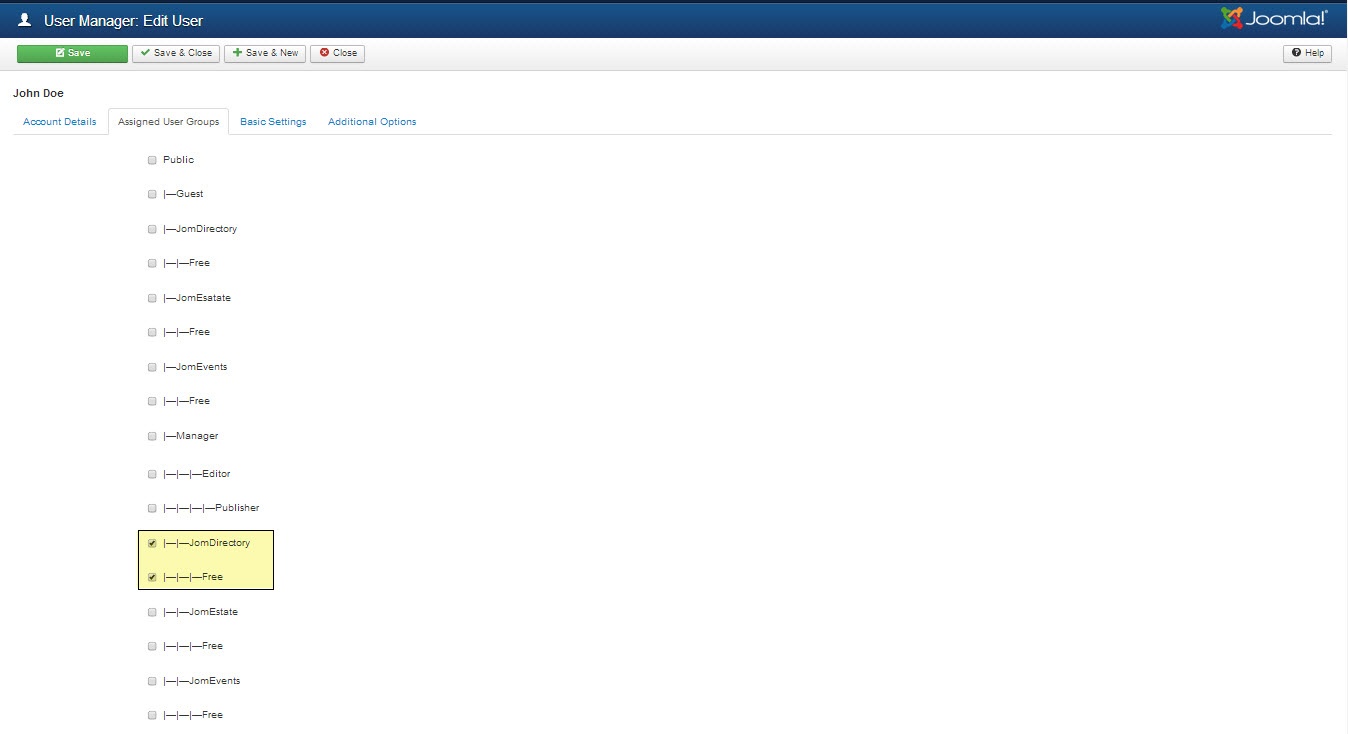Administrator's Guide
- Dashboard
- Address
- Categories
- Custom Fields
- Listings
- Listings Resources
- Resource Custom Fields
- Listing as Tours
- Tours Transport
- Listing Property Type
- Bookings
- Booking Addons
- Memebership
Dashboard
Overview
Administration dashboard gives you an overview of all the activities you can do using the JomHoliday extension. It provides you a view of all the menu items, system configuration checks, license information, and links to the documentation.
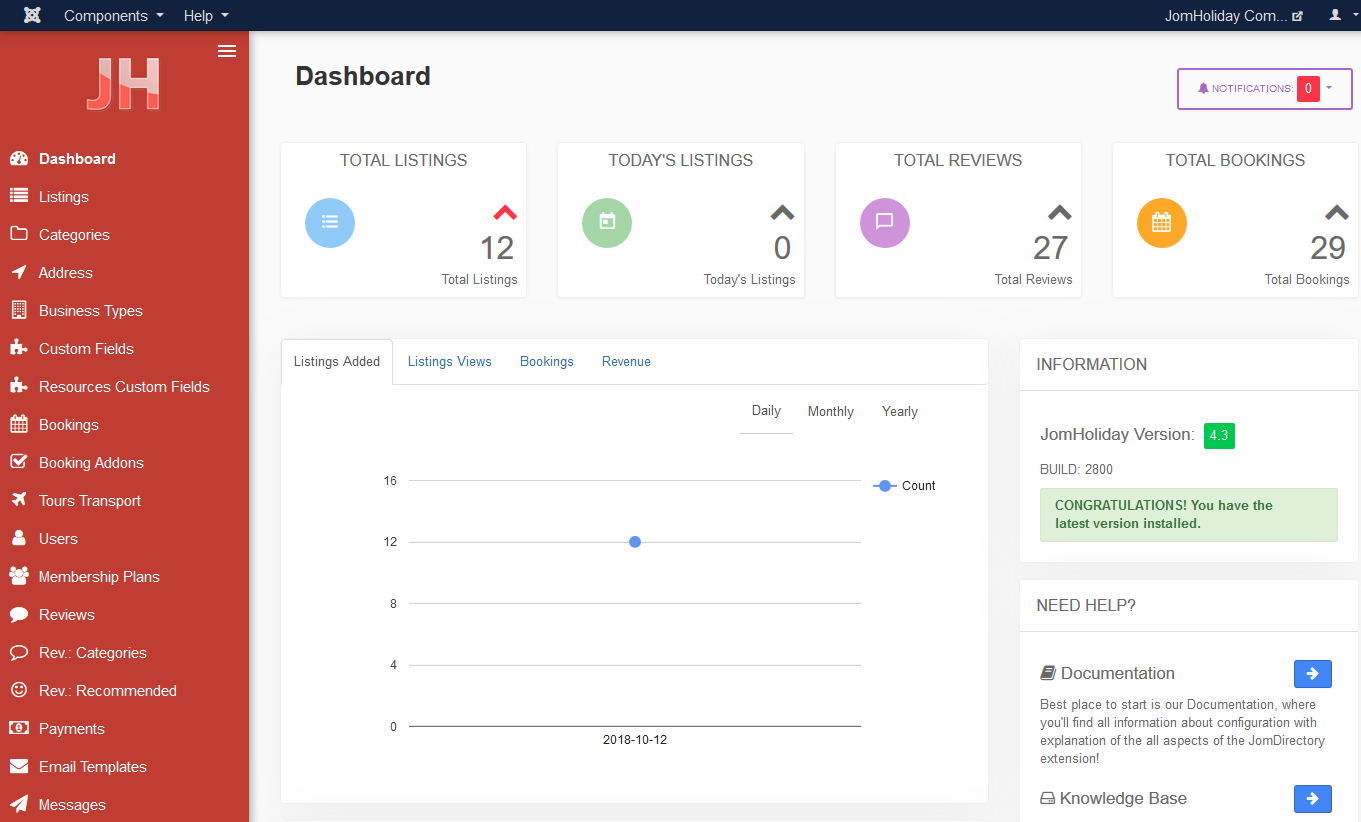
Screen 1: Dashboard screen
Menu Items
The following table provides an explanation about different menu items available:
|
Dashboard |
Home or dashboard for the JomHoliday extension |
|
Listings |
Shows the Listings administration screen |
|
Categories |
Shows the Categories administration screen |
|
Custom Fields |
Shows the Custom Fields administration screen |
| Resource Custom Fields | Shows the Resource Custom Fields administration screen |
|
Addresses |
Shows the Address administration screen |
| Business Types | Shows the Business Types administration screen |
| Bookings | Shows the Bookings administration screen |
| Booking Addons | Shows the Booking addons administration screen |
|
Membership Plans |
Shows the Membership Plans administration screen |
|
Messages |
Shows the messages received |
|
Reviews: Categories |
Shows the Reviews administration screen to add review parameters for each category. For example, Quality, Customer Service, and so on. |
|
Reviews: Recommended |
Shows screen to add recommended audience for the listing or category. For example, For young people, Gizmodo, and so on. |
|
Documentation |
Access the JomHoliday documentation. |
System Configuration Checks
Any configuration problems or current configuration status is displayed in this area as shown in the following screen:
Screen 3: System configuration checks area
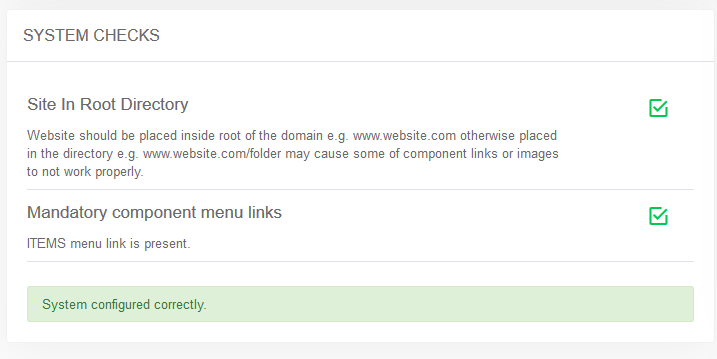
Address
Overview
The Address feature, as the name suggests, lets you provide the country, region and city for the respective product listing. The advantage with the Address field in Extensions is that after you configure a particular address, it is shared across various components in the Comdev extension.
Based on the depth of levels you want, such as the continent as Europe, country as the UK and region as Wales, you can configure the Address tree to have unlimited levels. The Address feature provides multilingual support. This means you can specify different names based on your language preference. For more information, see Languages.
Creating A New Address
The following image shows the Address Feature screen. To add an address, click Components > Comdev > Address. Click New to create a new address.
Screen 1: New Address screen
Let us understand each of the buttons seen on the screen using the following table.
|
New |
Creates a new Address entry. You must create separate entries for each level of depth that you need. |
|
Edit |
Provides the edit mode to make changes to the existing level or titles created. |
|
Publish |
Publishes the created address entry. |
|
Unpublish |
Removes the entry from the list of published address entries |
|
Archive |
Archives address entries that are not used anymore. |
|
Trash |
Deletes the address entry that is not required anymore. |
|
Rebuild |
Refreshes to incorporate the changes made to the entries in the Address feature. |
Address Structure
The structure of the Address tree is maintained as follows in our example. You can create any structure as per your requirement.
<Continent>
-- <Country>
-- – <Region>
-- – -- <City>
Editing address entries
If you want to edit existing entries, you can either click the entry from the Address screen or select the check box next to the entry, and then click Edit.
After you click the required entry that you need to edit, you can change the configurations based on the options as seen in the following table.
|
Title |
Custom Address Field |
|
Alias |
URL alias for “SEF/SEO” URL |
|
Parent |
Select the parent address entry |
|
Text box |
Provide a description about the entry. You can format the text using the formatting options in the text box. You can also insert images or links to URLs for more information. |
|
Category Image |
Upload an address image |
Publishing tab
After you have provided the above information, you can provide the publishing information in the Publishing tab as seen in the following image.
You can change the values for the given options using the following table.
|
Status |
Based on the status seen here, the visibility changes as follows:
|
|
Access |
Access level for site users is as follows:
|
|
Language |
Select the language for the address entry. |
|
ID |
Address ID, which can be used in modules, plugins and menus. |
|
Created by |
User name who created the entry. |
|
Created Date |
Date when the entry was created. |
|
Modified by |
User name who modified the entry. |
|
Modified Date |
Date when the entry was modified. |
Metadata tab
The metadata tab is used to provide metadata information for a particular address entry. The options for this tab can be seen as shown in the following image.
You can change the values for the given options using the following table.
|
Meta Description |
Meta-description for search-engine listings. |
|
Meta Keywords |
Meta Keywords for the search-engine |
|
Author |
Content author metadata. |
|
Robots |
Robots instructions:
|
Categories
Overview
Categories allow the site owner to categorize listings into appropriate sections. Extension categories are independent from the Joomla category system. Nested categories (sub-categories) are supported in Extension. Component comes with a category named "UNCATEGORIZED", which is the default setting. This category holds listing items that are not attached to any category (same function as the default Joomla system).
You can create a categories menu link under Menus using information provided here. Ensure that for creating this link you use the Item menu type as Categories.
Creating A New Category
The following image shows the Category Feature screen.
Screen 1: Adding a new category
Let us understand each of the buttons seen on the screen using the following table.
|
New |
Creates a new Category entry. You must create separate entries for each level of depth that you need. |
|
Edit |
Provides the edit mode to make changes to the existing level or titles created. |
|
Publish |
Publishes the created category entry. |
|
Unpublish |
Removes the entry from the list of published category entries |
|
Archive |
Archives category entries that are not used anymore. |
|
Trash |
Deletes the category entry that is not required anymore. |
|
Rebuild |
Refreshes to incorporate the changes made to the entries in the Category feature. |
Editing category entries
If you want to edit existing entries, you can either click the entry from the Category screen or select the check box next to the entry, and then click Edit.
New Category tab
The New Category tab is seen as shown in the following image:
Screen 2: New Category tab
After you click the required entry that you need to edit, you can change the configurations based on the options as seen in the following table.
|
Title |
Custom Category Field |
|
Alias |
URL alias for “SEF/SEO” URL |
|
Parent |
Select the parent category entry |
|
Text box |
Provide a description about the entry. You can format the text using the formatting options in the text box. You can also insert images or links to URLs for more information. |
|
Toggle editor |
Toggle between a rich text box with formatting options and plain text box. |
|
Category Image |
Upload a category image |
Publishing tab
After you have provided the above information, you can provide the publishing information in the Publishing as seen in the following image.
You can change the values for the given options using the following table.
|
Status |
Based on the status seen here, the visibility changes as follows:
|
|
Access |
Access level for site users is as follows:
|
|
Language |
Select the language for the category entry. |
|
ID |
Category ID, which can be used in modules, plugins and menus. |
|
Created by |
User name who created the entry. |
|
Created Date |
Date when the entry was created. |
|
Modified by |
User name who modified the entry. |
|
Modified Date |
Date when the entry was modified. |
Metadata tab
The metadata tab is used to provide metadata information for a particular category entry. The options for this tab can be seen as shown in the following image.
You can change the values for the given options using the following table.
|
Meta Description |
Meta-description for search-engine listings. |
|
Meta Keywords |
Meta Keywords for the search-engine |
|
Author |
Content author metadata. |
|
Robots |
Robots instructions:
|
Custom Fields
Overview
Custom fields are a powerful tool to build content. We provide a variety of field types with the ability to outline into groups. Each field can be assigned into a single category or all categories.
Creating a Custom Field
Creating a custom field involves setting certain options. To create a custom field, click New as shown in the following image.
Screen 1: Custom Field screen
The following table explains the different options available on the screen.
|
New |
Creates a new Custom Field. |
|
Edit |
Provides the edit mode to make changes to the existing level or titles created. |
|
Publish |
Publishes the created custom field. |
|
Unpublish |
Removes the entry from the list of published custom fields. |
|
Archive |
Archives custom fields that are not used anymore. |
|
Trash |
Deletes the custom fields that are not required anymore. |
|
Options |
Navigates to the Extension options screen. |
Editing Custom Fields
If you want to edit existing entries, you can either click the entry from the Custom Fields screen or select the checkbox next to the entry, and then click Edit.
Custom Field Edit
After you click the required entry that you need to edit, you can change the configurations for the fields as shown in the following image.
Screen 2: Custom Field Edit tab
The following table explains the different options seen on the screen:
Custom Field Edit |
Title |
Title for the Custom Field. |
|
Alias |
URL alias for “SEF/SEO” URL. |
|
|
Order |
Provide a value from 1 onwards. The lowest value will appear on the top. |
|
|
Field Required? |
Enable whether to make the field required. |
|
|
Category |
Category where the Custom Field will be published. When you select a custom field for a particular category, it is visible only for that category. While creating a listing if you select the said category and save, the custom field is available only then.
|
|
|
Field Type |
Set the Field Type for the Custom Field. For more information, see the Field Type Table. |
|
|
Field Database Type |
Set the field type, needed for database settings.
|
|
|
Field Group |
There are 5 custom field groups. Custom fields are grouped into groups. It has many advantages, one of them is display purposes. There are few groups available:
JomEstate, JomEvents only
Groups are static and cannot be created.
Paid groups are related to the membership plans that are applied to custom fields. Paid Items are displayed in the Items list, while the Paid Item is displayed in an Item (detailed) view.
|
|
|
Field Can Be Searched |
Enable to make the field values searchable. This setting applies only for the Search Module -> Layout Filter.
|
|
|
Field Search Type |
Provide the type of search option to include:
Depending on the Field search type you select, the search criteria field will be displayed in the search module – layout side search. This field is functional when the Field Type is selected as Input and Field can be searched set to Yes
|
|
|
Minimum Value |
When, as an example, the Range Dropdown option is selected, you can select the range between which the options can be selected. For example, for Price range between X and Y, with incremental steps of 2, you can set x value in this field. |
|
|
Maximum Value |
Set the Y value for the range in this field. |
|
|
Steps |
Define the incremental steps. For example, for increments of x+2, provide the value as 2. |
|
|
Custom Field Template |
Custom fields have own templates that can be used and customized. There are 3 templates available:
If you would like to create and customize your own templates, see the Developer Guide. |
|
|
ID |
This field is auto - generated. |
|
Custom fields values area |
Add new |
If the field type is selected to hold multiple values, this button lets you create the multiple values. |
|
Delete |
Delete the value. |
Custom Field Values
This area lets you create values when the field type requires multiple options to be provided.
For custom fields that can have values, to add multiple values, navigate to the custom fields listing screen. Click the ![]() icon next to the field where you want to add values as shown in the following image.
icon next to the field where you want to add values as shown in the following image.
Screen 3: Adding values to custom fields area
Here, the Field Type is selected as Checkbox and the Field Database Type has been stated as String. This means the Custom fields value area should provide options that can be seen when editing listing and displayed on the component front page. Hence, the Sample Values are provided in this area as Street, Garage, Underground. The following screen shows the values added at the back end. Click Delete to delete the entry.
Screen 4: Values added to custom field area
The following image shows how the field looks on the add listings page.
Screen 5: Custom Field as seen on new listing page
The custom field is seen on the listings page as shown in the following image:
Screen 6: Custom Field as seen on published listing page
Field Types
With Extension extension, you get several field types that you can create based on your requirement. The following image shows the available field types.

Screen 7: Field Types
The following table explains the different options seen on the screen.
|
Type |
Multiple select |
Multiple Values |
Description |
|
Radio button |
No |
Yes |
Standard radio button with multiple values |
|
Checkbox |
Yes |
Yes |
Standard check boxes with multiple values |
|
Dropdown |
No |
Yes |
Dropdown (select) field with multiple values |
|
Multiple Select |
Yes |
Yes |
Select box with multiple values |
|
Input |
No |
No |
Single text box |
|
Web Address |
No |
No |
Single text box for URL, it will display as the link in the front page |
|
|
No |
No |
Single text box for email |
|
Text |
No |
No |
Text area |
|
Date Time |
No |
No |
Select a date and time from the Calendar icon on screen. |
|
Date |
No |
No |
Select a date from the Calendar icon on screen. |
|
Editor textarea |
No |
No |
Creates a rich text editor box, it can be combined with Tabs group. |
Publishing tab
After you have provided the above information, you can provide the publishing information in the Publishing tab.
You can change the values for the given options using the following table.
|
Status |
Based on the status seen here, the visibility changes as follows:
|
|
Language |
Select the language for the address entry. To create a custom field that applies to a particular language, you need to select the appropriate language from the drop down. For each language that you want it to appear for, create a separate entry.
|
|
Created Date |
Date when the entry was created. |
|
Start Publishing |
Date when publishing needs to start in case of limited viewing of the field. |
|
Finish Publishing |
Date when publishing needs to stop in case of limited viewing of the field. |
|
Modified Date |
Date when the entry was modified. |
JomEstate custom fields: Beds, Baths, Garage
For custom fields such as Bed, Bath, and Garage, icons are displayed alongside. To change the style css for these icons, edit the jomestate.css file located in the components/com_jomestate/assets/css folder. These icons are only available for the single language. If the site is multilingual than additional suffixes are added, therefore additional styles needs to be created.
.beds .jd-lab-horizontal-float-icon {background: url("../images/beds.png") 0 50% no-repeat;}
.baths .jd-lab-horizontal-float-icon {background: url("../images/baths.png") 0 50% no-repeat;}
.garage .jd-lab-horizontal-float-icon {background: url("../images/car.png") 0 50% no-repeat;}Listings
Overview
Listings are nothing but the product listings that you want to create in the site. Each listing is attached to a category. They are created in the same manner as Joomla articles, but are not related to Joomla articles in definition.
Creating A New Listing
The following image shows the Listings screen.
Screen 1: Listing screen
The following table explains the different options seen on the screen.
|
New |
Creates a new Address entry. You must create separate entries for each level of depth that you need. |
|
Edit |
Provides the edit mode to make changes to the existing level or titles created. |
|
Publish |
Publishes the created address entry. |
|
Unpublish |
Removes the entry from the list of published address entries |
|
Archive |
Archives address entries that are not used anymore. |
|
Trash |
Deletes the address entry that is not required anymore. |
Edit Listing
If you want to edit existing entries, you can either click the entry from the Listings screen or select the check box next to the entry, and then click Edit.
This tab provides options to add title, description, select category, and other options for the Listing as seen in the following image:
Screen 2: Edit Listing screen
The following table shows the options available:
Edit Listing area |
Title |
Title for the Listing. |
|
Alias |
URL alias for “SEF/SEO” URL. |
|
|
Category |
Category where the listing will be published. |
|
Business Type |
Select the type of accomodation you need. | |
Advance Payment Required |
Select the percentage of advance payment required from 0 to 100 percent. | |
|
Text Area |
Provide a description for the listing. You can create a short description as well a long description. In the above image, the red dotted line appears when you click Read More. Any content above the red line is the short description, while the entire content is the long description. Also, note that if there is no content after the Read More tag, the event description will be blank when users view the listing. Ensure that you have content after the Read More tag.
|
|
|
Choose Article |
Click to select a relevant article. If an article is provided, it can be seen under the Details tab in the listing. |
|
|
Page Break Button |
Insert a page break in the displayed text. |
|
|
Toggle editor Button |
Toggle between plain text and rich text editor |
|
Read More |
Click to demarcate text that needs to be displayed as short description. | |
Address area |
Address |
Address of the listing |
|
Street, House No. |
Street and house number of the listing - If both Address and Full Address specified, map location will position automatically. |
|
Location area |
Latitude |
It utilizes the GEO-location based on Google Maps. Provide the latitude information for the location mapping. |
|
Maps longitude |
The information provided in this field is used to map the exact location. It utilizes the GEO-location based on Google Maps. Provide the longitude information for the location mapping. |
|
|
Maps Search |
Search for a specific location. Type in the location and press Enter to go to the exact location. |
|
Sidebar |
Featured |
Enable to make the listing appear as featured listing. |
|
Book Type |
Select if you would like to add e.g. Apartment with resource or Tours |
|
|
Book Now Type |
Select an Online Booking with build in calendar or by only Contact Form, 3'rd option is a redirect to external URL |
|
|
Approved |
Enable to approve the listing. Listing will not be published. |
|
|
Language |
Select the language for which the listing needs to appear for. For multiple languages, you must create separate entries for each language. |
|
|
Status |
Select the required status.
|
|
Owner |
Select the owner of the listing. | |
|
Created by |
Select the user who created the listing. |
|
|
Access |
Provide the access level for the listing.
|
|
|
Date created |
Select the date when the listing was created. You can select a future date for publishing the listing as well. |
|
|
Start Publishing |
Select a date when you want to publish the listing. Here too, you can schedule to post the listing at a future date. |
|
|
Finish Publishing |
Select a date when the listing should stop being published. |
|
|
Modified Date |
Select a date when the listing was modified. |
|
|
Tags |
Provide the tags for the listing. Tags are integrated and maintained with Joomla Tags Component. |
|
|
ID |
This is an auto-generated field. |
Understanding the Location area in Edit listing tab
Let us understand how to provide the address and Street/House No for providing the exact locations on the map. When you provide the address, street and House No. in the backend when creating listings, the location position automatically. If the House No. is not provided, additional location fields needs to be used.
Mapping using longitudes and latitudes
If you provide the latitudes and longitudes, and the Maps Search setting is left blank, the location mapping is done based on these parameters as shown in the following image.
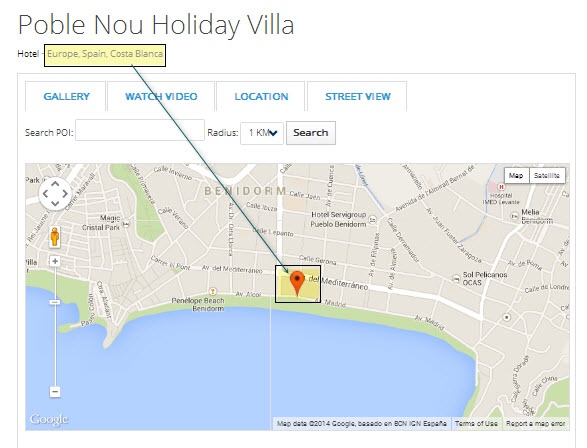
Screen 3: Map using longitudes and latitudes values
Mapping with Map Search values
If the Map Search field has a value provided to it, it takes precedence as shown in the following image. If the Map Search field value is given as “New York”, the location will map to this location.
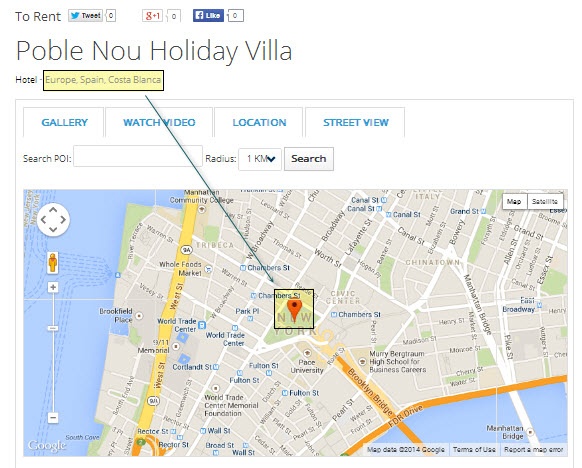
Screen 4: Map using Map Search Field values
Custom Fields tab
This tab includes all the custom fields created for a particular category. If the custom field is not applied to a specific category, it can be seen for all categories when creating a listing. The following image shows the Custom Fields tab screen.
Screen 5: Custom Fields tab
For more information about creating custom fields, see Custom Fields.
Images tab
This tab includes information about images and videos attached to the listing. Before you can add images to the listing, you must save your listing at least once. This ensure that all the other data you have filled for the listing does not disappear after the images are added.
The Images tab can be seen as shown in the following image:
Screen 6: Images tab
Provide the options as shown in the following table.
Images |
Add file area |
Add Files |
Click to select the image that needs to be uploaded. |
|
Drag & Drop Files Here |
Drag a bunch of images to this area to upload multiple images. |
||
|
Upload Into |
Select which category the image falls under:
|
||
|
Add available images & attachments |
Click to add already uploaded images and attachments to this listing. |
||
|
Images area |
Editing an Image |
Click the Click the |
|
|
Attachments area |
Click the Click the Attachments are detected automatically based on file extension that’s are allowed in Configuration . |
||
YouTube Video |
Provide the YouTube video URL in this field as shown in the following image.
|
Booking Addons tab
This tab provides options to select additional amenities or resources that the listing provides at additional cost. These are visible when booking process is started.
Screen 7: Booking Addons tab
For each addon that is added for a listing, you must set the Addon Price. Provide the price for each addon under the Addon Price column.
Metadata tab
This tab includes the Meta title and Meta description for the listing
Listings Resources
Overview
Resources are specific details about a listing. For example, in case of a Hotel, they can be the different types of rooms that the hotel offers, while in case of a property with multiple villas, it can be different types of villas that are offered. Bookings are always made against a resource type that exist for a listing.
Managing resources for a listing
For a listing created, you can either add a new resource or view the existing resources for that listing. These resources include the custom fields that were created using the Objects Custom Fields screen. The following screen shows the resources options. Please notice that for booking calendar Booking type must be Resource. Tours have static dates.
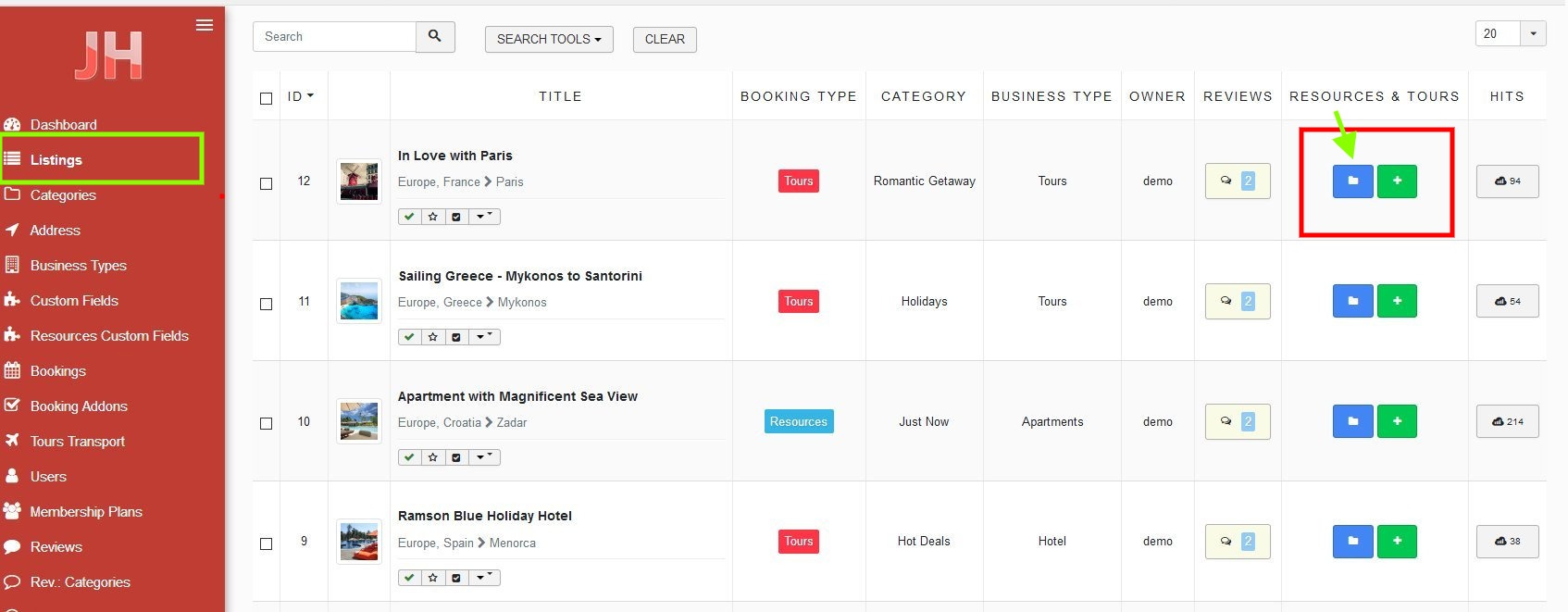
Screen 2: Resources options
To view the resources attached to a listing, click the FOLDER icon. To quickly create and add a new resource to the listing, click the PLUS icon. List of resources will appear. Click on resource title:

Add/Edit Resource tab
This tab provides options to create a name and alias for the type of resource.
Provide the options as seen in the following table.
| Title | Provide a name for the resource. |
| Alias | Provide an SEO-friendly alias. |
| Number of Resources | Number of resources same type available |
| Maximum Persons | Maximum number of people that can be accomodated. |
| Toggle Approve | Approved or not. |
| Modify Date | Select a effective date for the resource. |
| ID | This is an auto-generated field. |
Description tab
This tab provides the option to provide a detailed description about the resource.
Screen 3: Description tab
Provide the options as seen in the following table.
| Description | Provide a description for the resource. |
| Toggle Editor | Click to toggle between rich text and plain text editor. |
Custom Fields tab
This tab provides options to add required objects that were created using the Objects Custom Fields screen.
Screen 4: Custom Fields tab
Images tab
This tab includes information about images and videos attached to the listing. Before you can add images to the listing, you must save your listing at least once. This ensure that all the other data you have filled for the listing does not disappear after the images are added.
The Images tab can be seen as shown in the following image:
Screen 4: Images tab
Provide options as seen in the following table.
Images |
Add file area |
Add Files |
Click to select the image that needs to be uploaded. |
|
Drag & Drop Files Here |
Drag a bunch of images to this area to upload multiple images. |
||
|
Add available images & attachments |
Click to add already uploaded images and attachments to this listing. |
||
|
Images area |
Editing an Image |
Click the Click the |
Pricing for Resources
In the calendar seen in the earlier image, the dates marked with black ink are booked dates. This means there are no additional resources available for those dates. While, the dates marked with red ink are dates when resources are still available. This means a guest can make bookings against these dates marked in red.
Each date shows the price of the resource on that day and how many resources are left as shown in the following image.

Screen 4: Dates display
You can modify the price for the resource on each day by clicking on the date. Provide the pricing for that day for the resource. The following image shows the price window for the resource.

Screen 5: Price window
You can also provide promotional discounts for the listing on specific dates. After you provide the price for a date, the promotional discount window is seen as shown in the following image. Provide a percentage value as seen here.
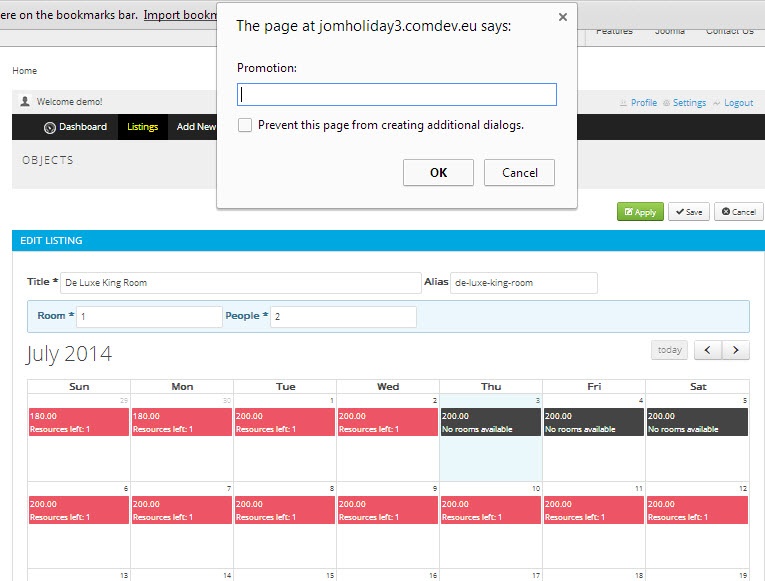
Screen 6: Promotional discount
If you need to set the same price and promotional discount for a range of dates, you can drag the mouse across the required dates and provide the price details as shown in the following image.

Resource Custom Fields
Overview
For every listing that is created, you can create custom fields that act as additional resources. For example, if a listing needs to add a resource such as utilities that include TV, Radio, DVD, and so on, this resource can be created using the Objects Custom Fields screen. The following image shows the listing for this field.
Screen 1: Resource Custom Fields listing
For more information about how to create custom fields, see the Custom Fields documentation in the Administrator Guide.
Listing as Tours
Overview
Tours are time based trips with fixed dates and prices, just like Resources, multiple Tours can be created. To create a tour for the listing, first it needs to be set under listing.
Managing Tours for a listing
For a listing created, you can either add a new tour or view the existing tours for that listing.
To view the tours attached to a listing, click the red folder icon. and Click on Tour title:
Edit tour tab
This tab provides options to create a name and edit a tour.
Provide the options as seen in the following table.
| Title | Provide a name for the tour. |
| Maximum Persons | Maximum number of people that can be accommodated within a tour. |
| Start Date | Tour start date |
| Days | Duration of the trip in days |
| Price | Price per one Adult |
| Price for kids | Price per one Child |
| Transport Type | Available Transport (configured under Tours Transport) |
| Description | Description of the trip |
Images tab
This tab includes information about images and videos attached to the listing. Before you can add images to the tour, you must save your tour at least once. This ensure that all the other data you have filled for the listing does not disappear after the images are added.
The Images tab can be seen as shown in the following image:
Screen 4: Images tab
Provide options as seen in the following table.
Images |
Add file area |
Add Files |
Click to select the image that needs to be uploaded. |
|
Drag & Drop Files Here |
Drag a bunch of images to this area to upload multiple images. |
||
|
Add available images & attachments |
Click to add already uploaded images and attachments to this listing. |
||
|
Images area |
Editing an Image |
Click the Click the |
Tours Transport
Overview
Multiple tours transport can be defined, which will be available under tours creation. Tours transport can be e.g. Plane or Bus.
Creating A New Tour Transport
The following table explains the different options seen on the screen.
|
New |
Creates a new Tour Transport entry. |
|
Edit |
Provides the edit mode to make changes to the existing ones. |
|
Publish |
Publishes the created tour entry. |
|
Unpublish |
Removes the entry from the list of published tour entries |
|
Archive |
Archives tour entries that are not used anymore. |
|
Trash |
Deletes the tour entry that is not required anymore. |
Edit TourTransport
If you want to edit existing entries, you can either click the entry from the Tours screen or select the check box next to the entry (title), and then click Edit.
The New Tour tab is seen as shown in the following image:
Screen 2: New Category tab screen
After you click the required entry that you need to edit, you can change the configurations based on the options as seen in the following table.
|
Title |
Provide a name for the Transport Type |
|
Alias |
URL alias for “SEF/SEO” URL |
|
Parent |
Select the parent entry |
|
Text box |
Provide a description about the entry. You can format the text using the formatting options in the text box. You can also insert images or links to URLs for more information. |
|
Category Imageyeh |
Upload an image for the type. |
Listing Property Type
Overview
Each of the listing that you create must be linked to a business type. Business type may include the type of accommodation the listing is about, such as Spa, cottage, apartment, and so on. The following image shows the Business Types listing.
Screen 1: Business Types listing
Editing Business Types
To create a new business type, click New. If you want to edit an existing Business Type, either click the entry or select the check box next to the entry, and then click Edit or just click on a title.
Screen 2: New Category tab screen
After you click the required entry that you need to edit, you can change the configurations based on the options as seen in the following table.
|
Title |
Provide a name for the Business Type |
|
Alias |
URL alias for “SEF/SEO” URL |
|
Parent |
Select the parent entry |
|
Text box |
Provide a description about the entry. You can format the text using the formatting options in the text box. You can also insert images or links to URLs for more information. |
|
Toggle editor |
Toggle between a rich text box with formatting options and plain text box. |
|
Category Image |
Upload an image for the type. |
Publishing tab
After you have provided the above information, you can provide the publishing information in the Publishing tab as seen in the following image.
You can change the values for the given options using the following table.
|
Status |
Based on the status seen here, the visibility changes as follows:
|
|
Access |
Access level for site users is as follows:
|
|
Language |
Select the language for the entry. |
|
ID |
Address ID, which can be used in modules, plugins and menus. |
|
Created by |
User name who created the entry. |
|
Created Date |
Date when the entry was created. |
Bookings
Overview
The bookings made through the site for any listing can be seen on this screen. The following image shows the list of bookings made on the site.
Screen 1: Bookings list
Viewing a booking
You can view the bookings seen on the screen by clicking on the entry. For a booking made, you can modify parameters such as payment status, resources, and so on.
Booking Details tab
This tab provides options to modify the payment status, no of guests, and so on as shown in the following image.
Screen 2: Booking Details tab
Edit the booking details as per the options in the following table.
| Arrive Date | Date of arrival |
| Depart Date | Date of departure |
| Booking Status | Edit the booking status as per the current payment status of the guest. |
| Payment Summary | Provide the amount paid by the guest. |
| Maximum Persons | Number of adults in the accomodation. |
| Children | Number of children in the accomodation. |
| User | User who created the listing. |
| ID | This is an auto generated field |
| Resources | This is an auto generated field based on the resources attached to the listing. |
| Notes | Additional information shared by the guest. |
| Toggle editor | Click to toggle between plain text and rich text editor. |
Payments & Checkout tab
This tab provides information about the payment method used by the guest for the booking and related details. This is a read only tab.
Booking Addons
Overview
After you click book for a particular listing, you can select additional facilities that the listing provides for an extra cost. These addons are added using the Booking Addons screen in the back end. The following image shows a list of addons.
Screen 1: Booking Addons listing
Editing an addon
To create a new addon, click New. To modify an existing addon, either click the entry or select the check box next to that entry, and then click Edit. The following image shows the Edit screen for an addon.
Screen 2: Editing an Addon
Provide the options as shown in the following table.
| Title | Provide a title for the addon. |
| Alias | Provide an SEO friendly alias. |
| Modify Date | Select the date when the addon entry was modified. |
| Toggle Approve | Approved |
| ID | This is an auto-generated field. |
Though you create an addon from the Booking Addons tab, the price for each addon varies based on the listing it is added too. Hence, the price is set as per the particular listing it is linked to. For more information about how to set the price, see Listings.
The addons options can be seen when you book a listing before confirming payment as seen in the following image.
Screen 3: Addons as seen on the listing
Memebership
Overview
Memberships in Extension are required to set user group level based on the monthly/Yearly pay plan the user selects. Using membership plans, you can decide how much to charge a user and how many listings a user can make for a particular membership plan.
Create a new Membership Plan
Click Components > Extension > Membership Plans > New to create a new membership plan as shown in the following image:
Screen 1: Create new membership plan
Edit Membership Plan
If you want to edit existing entries, you can either click the entry from the Membership screen or select the check box next to the entry, and then click Edit.
The following image shows the Edit Plan screen.
Screen 2: Edit Plan screen
The following table explains the different options seen.
|
Name |
Provide a name for the membership plan. |
|
Number of Listings |
Provide the number of listings the users in the plan can create. |
|
Group ID |
Select the Joomla user group ID for the plan. It is recommended that you create your membership under the Registered group.
|
|
Number of Images |
Provide the number of images the users in the plan can add. |
|
Price Monthly |
Provide the monthly charge for the plan. |
|
Price Annually |
Provide the annual charge for the plan. |
|
Best Value |
Best value badge, that shows in Front Admin (informative) |
|
No of Premium Listings |
Provide the number of premium listings the users in the plan can create. |
|
Attachments |
Enable to allow users to add attachments to listings. |
|
Video |
Enable to allow users to add Video link to the listings. |
| Custom Fields |
Enable custom fields for particular plan. Custom field needs to be assign into Paid Groups to be shown here.
|
|
ID |
This field is auto generated. |
Adding paid custom fields to the Membership plans
For adding a custom field to the membership plan, the field group needs to be set to Paid item. Click Extension > Custom Fields. Click the field you want to add to the membership plan as a paid item. Change the Field Group to Paid item for the Item view and Paid items for the Items view as shown in the following image:
Screen 4: Adding a paid custom field
This field needs to be enabled in the membership plan as shown in the following image.
Screen 5: Enabling the paid custom field
This field can be seen in the front admin under the membership plan as follows:
Screen 6: Viewing the paid custom field
Membership expiry email configurations
Before the membership expires, an email can be sent to a user that informs them about his membership nearing expiration. The setting can be seen in the following image:
Screen 3: Configure expiry email field
Cron Setting for Membership expiry check
Under your hosting panel a link needs to be added that launches a script. This script checks all users’ membership and sends an email if membership is about to expire:
curl -sS 'http://yourdomain.com?option=com_jomdirectory&task=expiry.send'or
wget -q -O /dev/null 'http://yourdomain.com?option=com_jomdirectory&task=expiry.send'If you are unaware about where the cron setting needs to configured in the hosting panel, contact your hosting support center.
Ensure that the script is launched every day at a particular time consistently.
Set Single User expiry date and group
To set plan expiry and attach a group for each user, do the following:
- Click Users > User Manager.
- Click the user for whom you want to set the membership expiry.
- Click the Additional Options tab.
- Provide the expiration date in the Plan expiry field.
- Click the Assigned User Groups tab.
- Select the check box next to the group you want to attach the user to for a particular membership plan as shown in the following image.
- Click Save.
For more information about membership expiration setting, see Configuration documentation.
